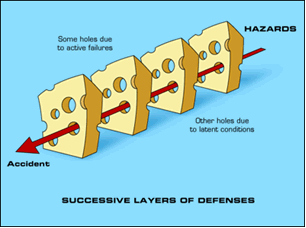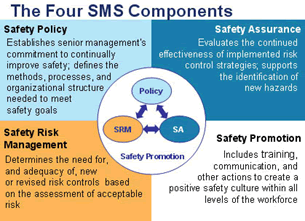| BlueSky Business Aviation News | ||||||||||||||||||||||
|
||||||||||||||||||||||
The performance is continuously measured, policies are changed up a bit or added if they need to be, and new risks are identified. Of course one of the critical aspects of the SMS is the continuous commitment from management and everyone involved. The SMS is only as good as its weakest player. The whole reason for this system is to save human lives and to protect property. A popular model used in the discussion of SMS and to demonstrate how accidents can happen is something called the Reason Model which was first presented by James Reason and Dante Orlandella from the University of Manchester in 1990. This is most commonly referred to as the “Swiss Cheese Model”. Now, you’d think that since these gentlemen were from England that they would have chosen Wensleydale, Shropshire Blue, or Stilton, instead they went with prepackaged sliced Swiss. Classy. But they had a good Reason.
I recently returned from the 12th World Congress of the International Critical Incident Response Foundation in Baltimore where I attended a one day symposium on Aviation Critical Incident Stress Management. The purpose of this symposium was for aviation professionals to share their experiences with helping their aviation departments recover after something terrible has happened; after all the slices of the cheese aligned and they have lost human life and property. When the system failed. A ‘Critical Incident’ is any incident that occurs in one’s life that changes them. It differs from daily stress because it is immediate and massive and it threatens the foundation of our mental health or our ability to function normally. A Critical Incident is mental trauma, and a very high risk to our mental health. Left untreated it can have dramatic effects on an individual’s ability to function, work, play, or even live. Critical Incident Stress Management, or CISM for short, is a mental health function that helps mitigate the risks associated with a Critical Incident. It involves the presence of mental health professionals directly after a critical incident and includes techniques to communicate, debrief, and defuse on both an individual and group level. It also includes peer support, which are colleagues trained in these techniques that the individual can better relate to. Typically a flight department would have a Critical Incident Response Plan (CIRP) that coincided with their Emergency Response Plan and would kick off at the same time. The CIRP’s function is to initiate the ongoing process of CISM during and after the emergency response.
My trip to Baltimore left me with a much better understanding of CISM and a great deal of respect for its purpose in our industry. My big thought after attending was this: The slices of cheese don’t just end when something terrible happens. In the wake of a Critical Incident there remains a huge lingering threat to human life and property. The Critical Incident immediately presents a new high risk to the flight department and to each individual involved, and the Critical Incident Response Plan is an essential part of this. The other take-away was that the incident doesn’t necessarily have to be the worst-case-scenario involving loss of life and property. A near miss, a runway incursion, severe turbulence, or responding to a medical emergency can all be life changing experiences and may affect you or your colleague’s ability to function normally and healthfully. This may result in another hole(s) in the cheese for your department. Pre-incident education is an important part of this. It helps everyone understand why it’s necessary and that taking good care of one’s mental health is not a weakness. It’s not cheesy - it’s crucial. If you don’t have a Critical Incident Response Plan built into your emergency response plan, I encourage you to look into it. For those with Safety Management Systems, possibly look at CISM as a risk post-incident and decide whether policy to mitigate it is appropriate. The Aircare CIRP is being offered to all business aviation flight departments at no charge regardless of size and whether you’re doing business with us or not. If you’d like more details on it send me a note. I’m stopping the cheese here but hope the importance of CISM and CIRP resonates with you all. Safe Flying.
Aircare Solutions Group, headquartered in Olympia WA., is comprised of business aviation companies that combined, provide Crewmember Emergency Procedures Training, Tele-medical Assistance, and Quality Crew Staffing to flight departments worldwide:
|
||||||||||||||||||||||


